In a world of magnified optics and compact red dots, the Skinner Peep Sight options stand out as an option unmatched by the latest technology. No batteries, no glass, and once adjusted, no moving parts. They’re low-profile, and made from steel or steel and brass. Most people can use them with or without corrective eye protection (prescription glasses). And they have almost zero learning curve. What is the secret behind this amazing sight? A very carefully drilled hole.
Peep sights, also known as aperture sights, have been around for over 200 years. Yet they are still in use today for both competition and by the military. Yes, those iron backups on the AR-15 and M-16 platforms are aperture sights. And they are used because the science behind them is simple: The aperture itself helps the eye focus on the front sight more easily. And the eye automatically centers the front post when using one. So unless you’re a better shot than an Olympic marksman, they are a viable option when you don’t want a scope or a reflex sight.
Skinner Peep Sight options for Rimfire Rifles
All Skinner peep sights are machined from solid bar stock. No plastic, no aluminum, and no casting. Finish options include stainless steel, polished brass, and blue. The first two are self-explanatory, the latter is carbon steel that has been treated with a hot dip black oxide finish. Skinner sights are as tough and durable as your firearm, which is why they are covered by a simple warranty: If it ever breaks, Skinner will repair it at no charge.
Is there a downside to all this magical-sounding goodness? Well, there may be some minor fitting required. And in some cases, the front sight may need to be replaced. Neither is outside the realm of most home gunsmiths. At most, a mallet, some punches, and a small file set are all that are needed to upgrade your rifle. I recently tried some Skinner Peep Sights on three popular rimfire rifles. Installation was easy, results were awesome. Note that they are also available for Marlin, Savage, Rossi, Tikka, Winchester, Mossberg, Browning, and other brands.
First up, Skinner Peep Sight on the CZ 457
The CZ 457 Scout is a great rifle for kids or small adults. It’s go a short length of pull and is scaled for short arms. But CZ went too far, with a barrel-mounted rear sight that gives it a dismal 10″ or so sight radius. Sliding a Skinner Peep Sight into the dovetail just behind the ejection port increased the sight radius by nearly 9 inches. Accuracy potential went way up with that simple change. With the Skinner in place, it’s easier to get on target quickly, and also hit targets out farther. This made my “irons only” CZ 457 much more satisfying to shoot.
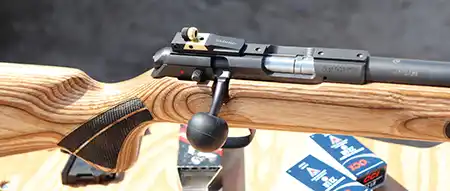
Due to slight variations in rifle manufacturer specifications, Skinner offers multiple sizes of dovetail sights. My CZ 457 dovetail was a bit on the small side for the sight they sent. Skinner offered to replace their sight, but I decided to fit the peep sight to another rifle. Note that this sight is $85 for the blue steel version, or $105 for the black gold (steel and brass) version. That includes wrenches for adjustments too.
Next up, Skinner Peep Sight on the Henry Frontier Lever Action
With a 24″ threaded barrel, the Henry Frontier is best shot suppressed. It’s super quiet when using subsonic ammo. And the long 20″ or so sight radius makes it fairly easy to score hits with little effort. After a bit of filing, my Skinner Peep Sight fit the Henry dovetail perfectly. Removing the fragile-looking rear sight and replacing it with the Skinner added an additional six inches to the sight radius. The brass and steel sight looks as though it should have been fitted at the factory too.
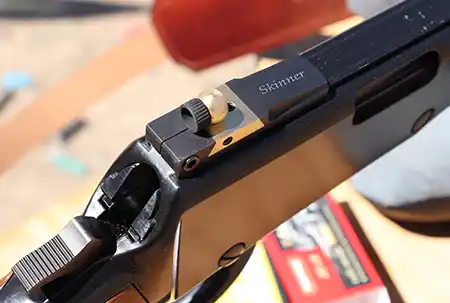
Even with a suppressor installed, the sights are usable. And the Skinner Peep Sight again improves the performance. Lining up an empty can or even an unbroken clay at 50 yards and drilling it quietly is quick and efficient. Working the lever for a follow-up shot doesn’t require losing your sight picture either. This rifle has always been one of the most popular options when I take friends and family shooting. And strangers always ask about it too. With some quick coaching on the peep sight function, everyone can enjoy cowboy-action hits. Pricing is the same as the CZ 457 sight.
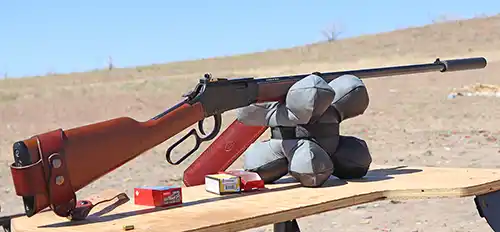
The Ruger American Rimfire did not get left out
It seems like there isn’t much support for Ruger’s American Rimfire line of rifles. One or two companies make stocks, and there is one trigger option that I am aware of. Which is unfortunate, as these are pretty decent shooters. Ruger didn’t help here, with the unusual design of their dovetail, which precludes sliding a peep sight on. I guess they figure most owners will use a scope, since the receiver is tapped for a base or rail. Skinner resolved this by using the rear holes in the receiver to mount their sight. It was the fastest install, as no fitting was required. Just tighten down the two screws evenly and carefully.
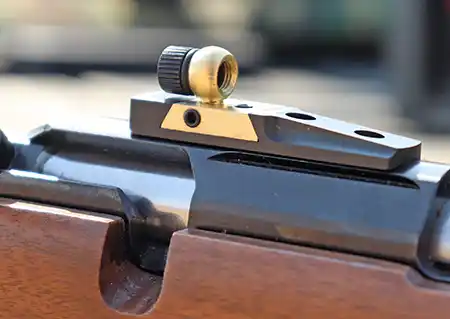
Since the original rear sight folds down, I left it in place. Factory sight radius was just 13.75 inches. With the Skinner Peep Sight installed at the back of the receiver, it’s now 20.5 inches. The day I wrote this article, I had repeat hits on an empty soda can at approximately 80 yards. Without my prescription glasses. That’s really pushing it for me, but it was not that challenging. Looking through the peep sight’s aperture, I placed the front green fiber optic dot on the reflective can, and pulled the trigger. Had the can not been reflective, I would hardly be able to see it at that distance. But I saw it, and heard the solid hits on it.
The peep sight in blue steel is $75. Mine is blue and brass, which sells for $95.
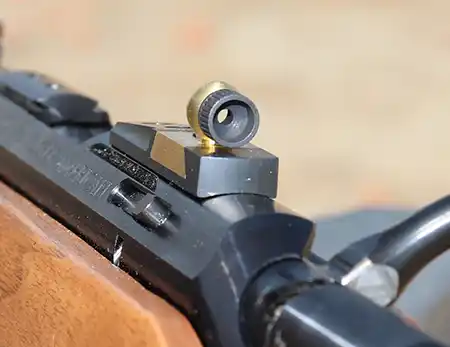
Installation of the Skinner Peep Sight for Rimfire Rifles
As you may have figured out, installation can vary a bit. That’s due to firearms tolerances, not Skinner’s. The CZ 457 and Henry dovetail should both be the same, but they are not. To accommodate this, Skinner makes the same sight in slightly different internal dovetail widths. When you place your order, you specify the firearm, and they choose the size that fits best, based on their experience. In some cases, the fit may be a bit tight. A few passes with a small triangle-shaped file was all it took to get a perfect fit on my Henry. It’s held in place by a single screw which pinches it to the dovetail.
No issues at all with the Skinner Peep Sight for the Ruger American Rimfire. The Ruger sight screwed down just like a scope base, as it mounts differently. All three were simple enough that I would expect most enthusiasts could manage it at home.
Adjustments and accessories
The Skinner Peep Sights I reviewed had only two available adjustments. Drifting the peep sight (or the front sight) adjusts windage, and a wrench is provided for the set screw. Elevation is adjusted by loosening the set screw and rotating the aperture stem. Raising or lowering the stem will affect the point of impact. My Ruger was hitting high, and lowering the stem all the way resolved that. Changing from subsonic to supersonic ammo may require another adjustment. Some rifles may require a taller front sight to work with the Skinner Peep Sight. Skinner offers some options to accommodate them. They also have a page with a comprehensive explanation of determining the correct front sight height.
When it comes to accessories, Skinner has a wider variety than I expected. In addition to the front sights mentioned above, they sell extra apertures and stems. Plus they have their own line of scopes in handy packages with rings included. You’ve even find a red dot for sale on their website. Along with a money belt, a ladder sight, optics mount, lens cleaner, and more. That includes a wealth of information about how peep sights work, and other interesting stuff. My main interest lies in the different apertures, so I’ll get into that next.
Aperture options
Reflex sights have dots from 1 to 6 MOA. Common scopes go to 7, 9, or even 25x magnification. Surely there are some options for the Skinner Peep Sight, right? Turns out there are a few. The standard aperture has a hole 0.096″ in diameter. This is a good general-purpose option. Larger apertures (0.125″ and 0.155″) are available for low-light situations. When the sight is mounted far forward, away from the shooter’s eye, these also work well. At the opposite end, there are finer (0.040″ and 0.070″) apertures. These are best for bright light, and target shooting. For most shooters, they won’t be as fast to use, at least not without practice. But they do allow for finer shot placement. Extra apertures are only $11, and don’t require tools to replace.

Final thoughts
Most of the time I’m shooting with a 25x scope off a bench or prone, and there’s not much of a challenge. Skinner sights have brought a lot of fun and simplicity back to my rimfire shooting. If I was looking to build a lightweight hunting rifle, this would be my first choice. They perform well out to the effective range of the .22 LR round. Nothing could be simpler, and they are even more durable than a rear leaf setup, while being faster and more accurate. In nearly every installation I can think of, they also extend the sight radius, which is another bonus. I’m not giving up my optics, but I now have multiple rifles dedicated to shooting with “irons only”. Even if those irons happen to be brass and steel.
I’d like to thank the folks at Skinner Sights for providing their excellent peep sights for my testing and evaluation. They make some truly awesome products, and back them with world-class customer service. Check them out at Skinnersights.com.
